|
|

This chapter covers the following elements of installing the MGX 8240 chassis:
Install the MGX 8240 in a clean, dry, well-ventilated area (see Table 3-1). Verify that a -48 VDC (approximately 40 Amps) source is close to where the chassis will be mounted. Also make sure there is an accessible site ground to connect to the equipment rack, or follow local wiring practices.
The MGX 8240 should be mounted in a standard 23-inch relay rack. Two MGX 8240 systems can fit in a single rack.
Leave space in front of and behind the MGX 8240 for installation, maintenance, and wiring. You will need at least 2.5 ft (0.75 m) clearance at the front of the rack and at least 2.0 ft (0.60 m) clearance at the rear of the rack. For details of switch size and specifications, see Table 2-2.
The unit vents vertically. Air is pulled in from the front and sides, and exits on the top and sides. Leave at least 5 inches between the top of the MGX 8240 and the shelf above it. The air filter fits at an angle in the lower section of the chassis (see Figure 3-1).
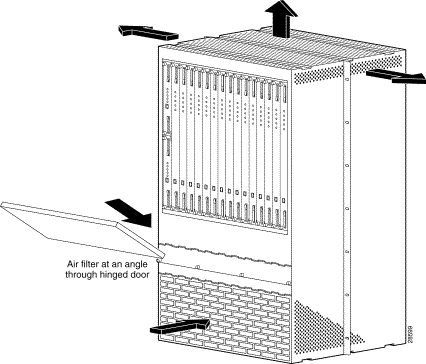
Certain site requirements (temperature and humidity, altitude, system grounding, and ESD/EMI precautions) must be met to ensure that the MGX 8240 unit functions well.
The MGX 8240 is intended for indoor use only. Table 3-1 lists the necessary shipping, storage, and operating temperatures.
| Condition | Specification |
|---|---|
Shipping temperature | -40 to +66 degrees C (-40 to +150.8 degrees F). |
Storage temperature | -30 to +50 degrees C (-22 to +122 degrees F). |
Operating temperature | 0 to 40 degrees C (32 to 104 degrees F). |
Relative humidity | 5% to 90% non-condensing. Note: Older chassis, mounted with the Common Interface Module, must have humidity between 20% and 80%. |
Altitude | Between 60 m (200 ft) and 4000 m (13,000 ft) above sea level. |
The MGX 8240 supports chassis ground (protective earth ground) for optimum performance as well as personal safety. All accessible surfaces that may become energized under a fault condition are connected to the ground.
Chassis ground points must be connected to the appropriate building ground points according to local wiring practices. Ground wires require a minimum diameter of 1.85 mm or 6 AWG (American Wire Gauge). If local codes allow grounding to the equipment rack only, ground wires are not required; use ground straps.
 |
Caution Before attempting to handle any electronic parts, put on an antistatic wrist strap (supplied) and connect it to the grounded equipment. The MGX 8240 has electro-static discharge (ESD) jacks in front and back. On the front panel, the ESD jack is at the left near the bottom of the far left PSM. On the back panel, the ESD jack is at the left near the bottom of the far left I/O Module. |
The MGX 8240 has been tested against all relevant standards of electromagnetic interference (EMI). However, Cisco recommends that users avoid placing the rack close to very strong EMI sources such as elevators, air-conditioners, photocopiers, and fax machines.
This section provides regulatory compliance and safety information for the MGX 8240 switch.
 |
Warning Only trained service personnel should install the equipment. |
 |
Warning Read the installation instructions before you connect the equipment to its power source. |
The MGX 8240 systems are intended for installation in a RESTRICTED ACCESS LOCATION.
The guidelines that follow help ensure your safety and protect the MGX 8240 equipment. The list of guidelines may not address all potentially hazardous situations in your working environment, so be alert, and exercise good judgement at all times.
The safety guidelines are
 |
Warning Before working on a chassis or working near power supplies, unplug the power cords on an AC-powered system. On a DC-powered system, disconnect the power at the circuit breakers. |
Follow these guidelines when working on equipment powered by electricity:
| |||
Waarschuwing | Dit waarschuwingssymbool betekent gevaar. U verkeert in een situatie die lichamelijk letsel kan veroorzaken. Voordat u aan enige apparatuur gaat werken, dient u zich bewust te zijn van de bij elektrische schakelingen betrokken risico's en dient u op de hoogte te zijn van standaard maatregelen om ongelukken te voorkomen. | ||
Varoitus | Tämä varoitusmerkki merkitsee vaaraa. Olet tilanteessa, joka voi johtaa ruumiinvammaan. Ennen kuin työskentelet minkään laitteiston parissa, ota selvää sähkökytkentöihin liittyvistä vaaroista ja tavanomaisista onnettomuuksien ehkäisykeinoista. | ||
Attention | Ce symbole d'avertissement indique un danger. Vous vous trouvez dans une situation pouvant causer des blessures ou des dommages corporels. Avant de travailler sur un équipement, soyez conscient des dangers posés par les circuits électriques et familiarisez-vous avec les procédures couramment utilisées pour éviter les accidents. | ||
Warnung | Dieses Warnsymbol bedeutet Gefahr. Sie befinden sich in einer Situation, die zu einer Körperverletzung führen könnte. Bevor Sie mit der Arbeit an irgendeinem Gerät beginnen, seien Sie sich der mit elektrischen Stromkreisen verbundenen Gefahren und der Standardpraktiken zur Vermeidung von Unfällen bewußt. | ||
Avvertenza | Questo simbolo di avvertenza indica un pericolo. La situazione potrebbe causare infortuni alle persone. Prima di lavorare su qualsiasi apparecchiatura, occorre conoscere i pericoli relativi ai circuiti elettrici ed essere al corrente delle pratiche standard per la prevenzione di incidenti. | ||
Advarsel | Dette varselsymbolet betyr fare. Du befinner deg i en situasjon som kan føre til personskade. Før du utfører arbeid på utstyr, må du vare oppmerksom på de faremomentene som elektriske kretser innebærer, samt gjøre deg kjent med vanlig praksis når det gjelder å unngå ulykker. | ||
Aviso | Este símbolo de aviso indica perigo. Encontra-se numa situação que lhe poderá causar danos físicos. Antes de começar a trabalhar com qualquer equipamento, familiarize-se com os perigos relacionados com circuitos eléctricos, e com quaisquer práticas comuns que possam prevenir possíveis acidentes. | ||
¡Atención! | Este símbolo de aviso significa peligro. Existe riesgo para su integridad física. Antes de manipular cualquier equipo, considerar los riesgos que entraña la corriente eléctrica y familiarizarse con los procedimientos estándar de prevención de accidentes. | ||
Varning! | Denna varningssymbol signalerar fara. Du befinner dig i en situation som kan leda till personskada. Innan du utför arbete på någon utrustning måste du vara medveten om farorna med elkretsar och känna till vanligt förfarande för att förebygga skador. | ||
| |||
Waarschuwing | Dit produkt dient volgens alle landelijke wetten en voorschriften te worden afgedankt. | ||
Varoitus | Tämän tuotteen lopullisesta hävittämisestä tulee huolehtia kaikkia valtakunnallisia lakeja ja säännöksiä noudattaen. | ||
Attention | La mise au rebut définitive de ce produit doit être effectuée conformément à toutes les lois et réglementations en vigueur. | ||
Warnung | Dieses Produkt muß den geltenden Gesetzen und Vorschriften entsprechend entsorgt werden. | ||
Avvertenza | L'eliminazione finale di questo prodotto deve essere eseguita osservando le normative italiane vigenti in materia. | ||
Advarsel | Endelig disponering av dette produktet må skje i henhold til nasjonale lover og forskrifter. | ||
Aviso | A descartagem final deste produto deverá ser efectuada de acordo com os regulamentos e a legislação nacional. | ||
¡Advertencia! | El desecho final de este producto debe realizarse según todas las leyes y regulaciones nacionales. | ||
Varning! | Slutlig kassering av denna produkt bör skötas i enlighet med landets alla lagar och föreskrifter. | ||
| |||
Waarschuwing | Tijdens onweer dat gepaard gaat met bliksem, dient u niet aan het systeem te werken of kabels aan te sluiten of te ontkoppelen. | ||
Varoitus | Älä työskentele järjestelmän parissa äläkä yhdistä tai irrota kaapeleita ukkosilmalla. | ||
Attention | Ne pas travailler sur le système ni brancher ou débrancher les câbles pendant un orage. | ||
Warnung | Arbeiten Sie nicht am System und schließen Sie keine Kabel an bzw. trennen Sie keine ab, wenn es gewittert. | ||
Avvertenza | Non lavorare sul sistema o collegare oppure scollegare i cavi durante un temporale con fulmini. | ||
Advarsel | Utfør aldri arbeid på systemet, eller koble kabler til eller fra systemet når det tordner eller lyner. | ||
Aviso | Não trabalhe no sistema ou ligue e desligue cabos durante períodos de mau tempo (trovoada). | ||
¡Advertencia! | No operar el sistema ni conectar o desconectar cables durante el transcurso de descargas eléctricas en la atmósfera. | ||
Varning! | Vid åska skall du aldrig utföra arbete på systemet eller ansluta eller koppla loss kablar. | ||
| |||
Waarschuwing | Alvorens aan apparatuur te werken die met elektrische leidingen is verbonden, sieraden (inclusief ringen, kettingen en horloges) verwijderen. Metalen voorwerpen worden warm wanneer ze met stroom en aarde zijn verbonden, en kunnen ernstige brandwonden veroorzaken of het metalen voorwerp aan de aansluitklemmen lassen. | ||
Varoitus | Ennen kuin työskentelet voimavirtajohtoihin kytkettyjen laitteiden parissa, ota pois kaikki korut (sormukset, kaulakorut ja kellot mukaan lukien). Metalliesineet kuumenevat, kun ne ovat yhteydessä sähkövirran ja maan kanssa, ja ne voivat aiheuttaa vakavia palovammoja tai hitsata metalliesineet kiinni liitäntänapoihin. | ||
Attention | Avant d'accéder à cet équipement connecté aux lignes électriques, ôter tout bijou (anneaux, colliers et montres compris). Lorsqu'ils sont branchés à l'alimentation et reliés à la terre, les objets métalliques chauffent, ce qui peut provoquer des blessures graves ou souder l'objet métallique aux bornes. | ||
Warnung | Vor der Arbeit an Geräten, die an das Netz angeschlossen sind, jeglichen Schmuck (einschließlich Ringe, Ketten und Uhren) abnehmen. Metallgegenstände erhitzen sich, wenn sie an das Netz und die Erde angeschlossen werden, und können schwere Verbrennungen verursachen oder an die Anschlußklemmen angeschweißt werden. | ||
Avvertenza | Prima di intervenire su apparecchiature collegate alle linee di alimentazione, togliersi qualsiasi monile (inclusi anelli, collane, braccialetti ed orologi). Gli oggetti metallici si riscaldano quando sono collegati tra punti di alimentazione e massa: possono causare ustioni gravi oppure il metallo può saldarsi ai terminali. | ||
Advarsel | Fjern alle smykker (inkludert ringer, halskjeder og klokker) før du skal arbeide på utstyr som er koblet til kraftledninger. Metallgjenstander som er koblet til kraftledninger og jord blir svært varme og kan forårsake alvorlige brannskader eller smelte fast til polene. | ||
Aviso | Antes de trabalhar em equipamento que esteja ligado a linhas de corrente, retire todas as jóias que estiver a usar (incluindo anéis, fios e relógios). Os objectos metálicos aquecerão em contacto com a corrente e em contacto com a ligação à terra, podendo causar queimaduras graves ou ficarem soldados aos terminais. | ||
¡Advertencia! | Antes de operar sobre equipos conectados a líneas de alimentación, quitarse las joyas (incluidos anillos, collares y relojes). Los objetos de metal se calientan cuando se conectan a la alimentación y a tierra, lo que puede ocasionar quemaduras graves o que los objetos metálicos queden soldados a los bornes. | ||
Varning! | Tag av alla smycken (inklusive ringar, halsband och armbandsur) innan du arbetar på utrustning som är kopplad till kraftledningar. Metallobjekt hettas upp när de kopplas ihop med ström och jord och kan förorsaka allvarliga brännskador; metallobjekt kan också sammansvetsas med kontakterna. | ||
| |||
Waarschuwing | U dient de voeding niet aan te raken zolang het netsnoer aangesloten is. Bij systemen met een stroomschakelaar zijn er lijnspanningen aanwezig in de voeding, zelfs wanneer de stroomschakelaar uitgeschakeld is en het netsnoer aangesloten is. Bij systemen zonder een stroomschakelaar zijn er lijnspanningen aanwezig in de voeding wanneer het netsnoer aangesloten is. | ||
Varoitus | Älä kosketa virtalähdettä virtajohdon ollessa kytkettynä. Virrankatkaisimella varustetuissa järjestelmissä on virtalähteen sisällä jäljellä verkkojännite, vaikka virrankatkaisin on katkaistu-asennossa virtajohdon ollessa kytkettynä. Järjestelmissä, joissa ei ole virrankatkaisinta, on virtalähteen sisällä verkkojännite, kun virtajohto on kytkettynä. | ||
Attention | Ne pas toucher le bloc d'alimentation quand le cordon d'alimentation est branché. Avec les systèmes munis d'un commutateur marche-arrêt, des tensions de ligne sont présentes dans l'alimentation quand le cordon est branché, même si le commutateur est à l'arrêt. Avec les systèmes sans commutateur marche-arrêt, l'alimentation est sous tension quand le cordon d'alimentation est branché. | ||
Warnung | Berühren Sie das Netzgerät nicht, wenn das Netzkabel angeschlossen ist. Bei Systemen mit Netzschalter liegen Leitungsspannungen im Netzgerät vor, wenn das Netzkabel angeschlossen ist, auch wenn das System ausgeschaltet ist. Bei Systemen ohne Netzschalter liegen Leitungsspannungen im Netzgerät vor, wenn das Netzkabel angeschlossen ist. | ||
Avvertenza | Non toccare l'alimentatore se il cavo dell'alimentazione è collegato. Per i sistemi con un interruttore di alimentazione, tensioni di linea sono presenti all'interno dell'alimentatore anche quando l'interruttore di alimentazione è en posizione di disattivazione (off), se il cavo dell'alimentazione è collegato. Per i sistemi senza un interruttore, tensioni di linea sono presenti all'interno dell'alimentatore quando il cavo di alimentazione è collegato. | ||
Advarsel | Berør ikke strømforsyningsenheten når strømledningen er tilkoblet. I systemer som har en strømbryter, er det spenning i strømforsyningsenheten selv om strømbryteren er slått av og strømledningen er tilkoblet. Når det gjelder systemer uten en strømbryter, er det spenning i strømforsyningsenheten når strømledingen er tilkoblet. | ||
Aviso | Não toque na unidade abastecedora de energia quando o cabo de alimentação estiver ligado. Em sistemas com interruptor, a corrente eléctrica estará presente na unidade abastecedora, sempre que o cabo de alimentação de energia estiver ligado, mesmo quando o interruptor se encontrar desligado. Para sistemas sem interruptor, a tensão eléctrica dentro da unidade abastecedora só estará presente quando o cabo de alimentação estiver ligado. | ||
¡Advertencia! | No tocar la fuente de alimentación mientras el cable esté enchufado. En sistemas con interruptor de alimentación, hay voltajes de línea dentro de la fuente, incluso cuando el interruptor esté en Apagado (OFF) y el cable de alimentación enchufado. En sistemas sin interruptor de alimentación, hay voltajes de línea en la fuente cuando el cable está enchufado. | ||
Varning! | Vidrör inte strömförsörjningsenheten när nätsladden är ansluten. För system med strömbrytare finns det nätspänning i strömförsörjningsenheten även när strömmen har slagits av men nätsladden är ansluten. För system utan strömbrytare finns det nätspänning i strömförsörjningsenheten när nätsladden är ansluten. | ||
| |||
Waarschuwing | Voordat u aan een frame of in de nabijheid van voedingen werkt, dient u bij wisselstroom toestellen de stekker van het netsnoer uit het stopcontact te halen; voor gelijkstroom toestellen dient u de stroom uit te schakelen bij de stroomverbreker. | ||
Varoitus | Kytke irti vaihtovirtalaitteiden virtajohto ja katkaise tasavirtalaitteiden virta suojakytkimellä, ennen kuin teet mitään asennuspohjalle tai työskentelet virtalähteiden läheisyydessä. | ||
Attention | Avant de travailler sur un châssis ou à proximité d'une alimentation électrique, débrancher le cordon d'alimentation des unités en courant alternatif ; couper l'alimentation des unités en courant continu au niveau du disjoncteur. | ||
Warnung | Bevor Sie an einem Chassis oder in der Nähe von Netzgeräten arbeiten, ziehen Sie bei Wechselstromeinheiten das Netzkabel ab bzw. schalten Sie bei Gleichstromeinheiten den Strom am Unterbrecher ab. | ||
Avvertenza | Prima di lavorare su un telaio o intorno ad alimentatori, scollegare il cavo di alimentazione sulle unità CA; scollegare l'alimentazione all'interruttore automatico sulle unità CC. | ||
Advarsel | Før det utføres arbeid på kabinettet eller det arbeides i nærheten av str¿mforsyningsenheter, skal str¿mledningen trekkes ut p vekselstrømsenheter og strømmen kobles fra ved strømbryteren på likestrømsenheter. | ||
Aviso | Antes de trabalhar num chassis, ou antes de trabalhar perto de unidades de fornecimento de energia, desligue o cabo de alimentação nas unidades de corrente alternada; desligue a corrente no disjuntor nas unidades de corrente contínua. | ||
¡Advertencia! | Antes de manipular el chasis de un equipo o trabajar cerca de una fuente de alimentación, desenchufar el cable de alimentación en los equipos de corriente alterna (CA); cortar la alimentación desde el interruptor automático en los equipos de corriente continua (CC). | ||
Varning! | Innan du arbetar med ett chassi eller nära strömförsörjningsenheter skall du för växelströmsenheter dra ur nätsladden och för likströmsenheter bryta strömmen vid överspänningsskyddet. | ||
| |||
Waarschuwing | Voordat u aan een systeem werkt dat een aan/uit schakelaar heeft, dient u de stroomvoorziening UIT te schakelen en de stekker van het netsnoer uit het stopcontact te halen. | ||
Varoitus | Ennen kuin teet mitään sellaiselle järjestelmälle, jossa on kaksiasentokytkin, katkaise siitä virta ja kytke virtajohto irti. | ||
Attention | Avant de travailler sur un système équipé d'un commutateur marche-arrêt, mettre l'appareil à l'arrêt (OFF) et débrancher le cordon d'alimentation. | ||
Warnung | Bevor Sie an einem System mit Ein/Aus-Schalter arbeiten, schalten Sie das System AUS und ziehen das Netzkabel aus der Steckdose. | ||
Avvertenza | Prima di lavorare su un sistema dotato di un interruttore on/off, spegnere (OFF) il sistema e staccare il cavo dell'alimentazione. | ||
Advarsel | Slå AV strømmen og trekk ut strømledningen før det utføres arbeid på et system som er utstyrt med en av/på-bryter. | ||
Aviso | Antes de começar a trabalhar num sistema que tem um interruptor on/off, DESLIGUE a corrente eléctrica e retire o cabo de alimentação da tomada. | ||
¡Advertencia! | Antes de utilizar cualquier sistema equipado con interruptor de Encendido/Apagado (ON/OFF), cortar la alimentación y desenchufar el cable de alimentación. | ||
Varning! | Slå AV strömmen och dra ur nätsladden innan du utför arbete på ett system med strömbrytare. | ||
| |||
Waarschuwing | Deze apparatuur hoort geaard te worden Zorg dat de host-computer tijdens normaal gebruik met aarde is verbonden. | ||
Varoitus | Tämä laitteisto on tarkoitettu maadoitettavaksi. Varmista, että isäntälaite on yhdistetty maahan normaalikäytön aikana. | ||
Attention | Cet équipement doit être relié à la terre. S'assurer que l'appareil hôte est relié à la terre lors de l'utilisation normale. | ||
Warnung | Dieses Gerät muß geerdet werden. Stellen Sie sicher, daß das Host-Gerät während des normalen Betriebs an Erde gelegt ist. | ||
Avvertenza | Questa apparecchiatura deve essere collegata a massa. Accertarsi che il dispositivo host sia collegato alla massa di terra durante il normale utilizzo. | ||
Advarsel | Dette utstyret skal jordes. Forviss deg om vertsterminalen er jordet ved normalt bruk. | ||
Aviso | Este equipamento deverá estar ligado à terra. Certifique-se que o host se encontra ligado à terra durante a sua utilização normal. | ||
¡Advertencia! | Este equipo debe conectarse a tierra. Asegurarse de que el equipo principal esté conectado a tierra durante el uso normal. | ||
Varning! | Denna utrustning är avsedd att jordas. Se till att värdenheten är jordad vid normal användning. | ||
| |||
Waarschuwing | Raadpleeg de installatie-aanwijzingen voordat u het systeem met de voeding verbindt. | ||
Varoitus | Lue asennusohjeet ennen järjestelmän yhdistämistä virtalähteeseen. | ||
Attention | Avant de brancher le système sur la source d'alimentation, consulter les directives d'installation. | ||
Warnung | Lesen Sie die Installationsanweisungen, bevor Sie das System an die Stromquelle anschließen. | ||
Avvertenza | Consultare le istruzioni di installazione prima di collegare il sistema all'alimentatore. | ||
Advarsel | Les installasjonsinstruksjonene før systemet kobles til strømkilden. | ||
Aviso | Leia as instruções de instalação antes de ligar o sistema à sua fonte de energia. | ||
¡Atención! | Ver las instrucciones de instalación antes de conectar el sistema a la red de alimentación. | ||
Varning! | Läs installationsanvisningarna innan du kopplar systemet till dess strömförsörjningsenhet. | ||
| |||
Waarschuwing | Klasse-1 laser produkt. | ||
Varoitus | Luokan 1 lasertuote. | ||
Attention | Produit laser de classe 1. | ||
Warnung | Laserprodukt der Klasse 1. | ||
Avvertenza | Prodotto laser di Classe 1. | ||
Advarsel | Laserprodukt av klasse 1. | ||
Aviso | Produto laser de classe 1. | ||
¡Advertencia! | Producto láser Clase I. | ||
Varning! | Laserprodukt av klass 1. | ||
| |||
Waarschuwing | Niet in de straal staren of hem rechtstreeks bekijken met optische instrumenten. | ||
Varoitus | Älä katso säteeseen äläkä tarkastele sitä suoraan optisen laitteen avulla. | ||
Attention | Ne pas fixer le faisceau des yeux, ni l'observer directement à l'aide d'instruments optiques. | ||
Warnung | Nicht direkt in den Strahl blicken und ihn nicht direkt mit optischen Geräten prüfen. | ||
Avvertenza | Non fissare il raggio con gli occhi né usare strumenti ottici per osservarlo direttamente. | ||
Advarsel | Stirr eller se ikke direkte p strlen med optiske instrumenter. | ||
Aviso | Não olhe fixamente para o raio, nem olhe para ele directamente com instrumentos ópticos. | ||
¡Advertencia! | No mirar fijamente el haz ni observarlo directamente con instrumentos ópticos. | ||
Varning! | Rikta inte blicken in mot strålen och titta inte direkt på den genom optiska instrument. | ||
To install the MGX 8240 chassis, you will need the following:
 |
Caution An antistatic wrist strap must be worn during installation to prevent electrostatic damage to the MGX 8240. |
 |
Caution Three people are needed to lift the chassis. If three people are not available, use a hand lift. |
Check the "Tip-and-Tell" and "G-Shok" indicators on the outside of the boxes. If either one indicates that the package has been damaged, note the indication on the shipping manifest. Unpack the box(es) and check the package's contents. If the box has been damaged, or if some parts are missing or defective, call 800-553-2447 and the package carrier to report the damage. Obtain a Returned Material Authorization (RMA) number and include the RMA number on the label. Return the unit in original packaging.
The following sections describe the procedures required to mount the MGX 8240 and bring it on line.
After site preparation, the first step in installing a chassis is mounting it in a rack. Follow the steps below.
 |
Caution Before attempting to handle electronic parts, put on a grounded antistatic wrist strap. |
Step 1 Use the bolt-positioning template to plan position of bolts. You may find it helpful to install some bolts from the back to the front before lifting the chassis into place.
Position the chassis at the top of the equipment rack or otherwise as planned by engineers. Cisco recommends that installers have three people available to lift the chassis, and have a fourth person to bolt the chassis into place. If three people are not available, use a hand lift.
Step 2 Connect the chassis ground wire to the signal "GND" lug on the rear of the chassis.
The MGX 8240 requires -42 VDC to -56 VDC power at 50 Amps maximum for a fully loaded shelf. To connect the power, follow the steps below.
 |
Warning Make sure power is turned off at source before connecting power source to chassis. |
Step 1 The MGX 8240 supports dual DC feeds. Determine if you want two feeds or one.
Step 2 Connect power wires from DC power source to chassis terminal block. Use dual ring terminal lugs (Cisco part number 27-1183-01 or Thomas & Betts part number 54852BE) & #6 AWG stranded wire. Connect the -48VDC to the terminal marked A-PWR. Connect the -48VDC Return to the terminal marked A-RET.
Step 3 If you want a redundant power feed to be supplied to the chassis, connect to the B-PWR & B-RET terminals.
Step 4 Ground the chassis using a dual ring terminal lugs to the terminal marked GND.
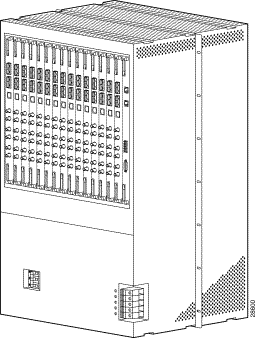
| Cable Type | Connector Type | Purpose |
|---|---|---|
Power | #6 AWG lug | Supplies -48 VDC power to the MGX 8240 |
The MGX 8240 has 15 full-size slots and 2 half-size slots. An IMC front card fits into each of the two half-size slots.
Redundancy for IMC cards is usually used, but it is optional. For redundancy, install two IMC cards (one primary and one backup).
IMC cards are hot-swappable. However, whenever there is a forced SwitchOver to standby IMC, all the active telnet and ftp sessions need to be re-established. Any current ftp sessions would be terminated, and all telnet sessions would hang.
Some shipments of MGX 8240 chassis come with IMC cards already installed. If yours does not, perform the following steps to install the modules on the front of the chassis:
Step 1 Place the IMC in the tracks in the first slot on the front of the chassis, which is a divided slot. Slide the card forward until you feel a slight resistance, then put your thumbs on the thumb levers and push the module gently into place.
 |
Note Generally, users with two IMC cards put the primary card in the top half slot. Generally, users with only one IMC card put it in the top half slot. See Figure 2-3. |
 |
Warning Improper insertion of card can damage the midplane. |
Step 2 If you are using a second IMC card, place the second IMC in the unused half-slot.
 |
Note The FACTORY RS232 connector on the front of the IMC card is for manufacturing purposes only—do not use it. |
Some shipments of MGX 8240 chassis come with IMC I/O cards already installed. If yours does not, perform the following steps to install the modules on the front of the chassis:
One IMC I/O card fits into a single slot in the back of the chassis; one IMC I/O card can support one or two IMC front cards. For more details about IMC cards see "IMC Card" section.
Step 1 Place the IMC I/O in the tracks in the first slot (this slot, on the back of the chassis, corresponds to the divided slot on the front of the chassis). Slide the card forward until you feel a slight resistance, then put your thumbs on the thumb levers and push the module gently into place.
 |
Warning Improper insertion of card can damage the midplane. |
Some shipments of MGX 8240 chassis come with PSM cards already installed. If yours does not, perform the following steps to install the modules on the front of the chassis:
Step 1 Place the PSM in the tracks in slot 2 on the front of the chassis. Slide the card forward until you feel a slight resistance, then put your thumbs on the thumb levers and push the module gently into place.
 |
Warning Improper insertion of card can damage the midplane. |
Step 2 Place the remaining 14 PSMs in the same manner.
 |
Note The FACTORY RS232 connector on the front of the PSM card is for manufacturing purposes only—do not use it. |
To install the PSM I/O modules on the rear of the chassis, perform the following steps:
Step 1 Put the I/O into slot 2 on the back of the chassis. Slide it in until you feel a slight resistance, then put your thumbs on the thumb levers and push the module gently into place.
Step 2 Attach the remaining I/O modules into their respective slots.
Step 3 Use blank I/O faceplates to cover any unused slots
For more information on PSM I/O modules, see"PSM Module and Faceplates" section.
The MGX 8240 provides two types of network connections (see Table 3-3):
1. DS3 Channelized Access with BNC connectors.
2. OC3 Single-Mode Intermediate Reach fiber unchannelized for ATM network.
The DS3 channelized access typically connects to Digital Cross-Connect Systems (DCS) or M13 multiplexers via a DSX-3 cross-connect panel. The DS3 connectors are located on each rear I/O panel (slots 2-16).
Perform the following steps to make the connection:
Step 1 Connect the BNC on the DS3 access Tx port to the Rx of far end equipment. Use the lower cable tray.
Step 2 Connect the BNC on the Rx port to the Tx port of the far end equipment. User the lower cable tray.
Step 3 Repeat Steps 1 and 2 for each of the remaining DS3 connections.
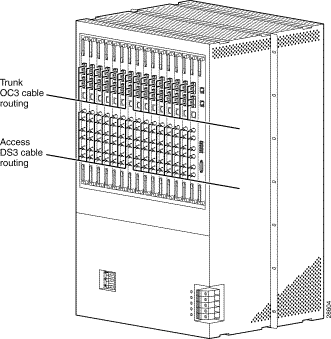
| Cable Type | Connector Type | Purpose |
|---|---|---|
Channelized DS3 | BNC | Supply DS3 connectivity to customer equipment |
OC3 | SC | Supply OC3 connectivity to network equipment |
The OC3 ATM trunk connects to ATM core switches via a fiber optics patch panel. The OC3 ATM trunks support bidirectional and unidirectional, non-revertive 1+1 Automatic Protection Switching (APS). Perform the following steps to connect the OC3 ATM trunk:
Step 1 Starting with the PSM in slot two, connect the top network OC3 connector(OC3-1) to the primary trunk connection.
Step 2 Connect the bottom network OC3 connector (OC3-2) to the associated backup circuit. Use the upper cable tray.
Step 3 Repeat for all remaining PSM cards.
The MGX 8240 has two BITS inputs labeled Ref CLK A and Ref CLK B. Both inputs are identical; if you are installing only one BITS source, it does not matter which input you use. The connections are characterized by three wires labeled T (Tip), R (Ring), and S (Signal Ground).
The BITS Clock Source should be a DS1, B8ZS signal from Stratum 3 or higher clock source. The clock source is terminated at the unit.
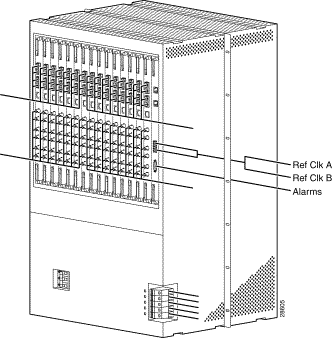
To start the MGX 8240, perform the following steps:
Step 1 Turn the power switch to the ON position.
Step 2 Verify that the Ready LED turns green after each card completes its Power On Self Test (this may take up to ten minutes).
 |
Note If the Ready LED does not turn green after ten minutes, contact TAC. |
On power up, the PSM starts diagnostics, including register, RAM, and control (interrupts). Where appropriate, multiple functional blocks are tested, with the use of loopback functionality. The Startup BERT Loopback test follows the hardware diagnostics.
After each sub-system has been individually tested, the data paths between sub-systems are tested. After the diagnostics are completed, the PSM loads the Operating software from flash into RAM. Then the PSM reads and processes the configuration files from the Flash. By doing so, the system configures ports and makes connections. After all the configuration files are executed, the Ready LED turns green, signalling that provisioning is finished.
The internal OAM Loopback test runs continuously. If it fails, the health monitor reboots the system.
Before you can use the VCLI to configure the IMC card, you must do FDOS. FDOS is done via the CMDR software installed on the card. Users access the CMDR software via PC, VT-100, or other dumb terminal, via an RS232 terminal connection.
Perform the following steps to make an RS232 terminal connection to the IMC I/O card:
Step 1 Connect one end of a standard RJ45 8-Connector cable to the DB9 adaptor, with the following pinouts:
| RJ45 Socket | DB9 Female | |||
|---|---|---|---|---|
pin# | Signal Name |
| Sgnal Name | pin# |
NC |
|
| DCD | 1 |
3 | TXD |
| RXD | 2 |
6 | RXD |
| TXD | 3 |
7 | DSR |
| DTR | 4 |
4 | GND |
| GND | 5 |
2 | DTR |
| DSR | 6 |
8 | RTS |
| RTS | 7 |
1 | CTS |
| CTS | 8 |
NC |
|
| RI | 9 |
Step 2 Connect the DB9 adaptor to the serial port of your VT-100 (or PC) terminal.
Step 3 Connect the other end of the cable to the RS232 console port on the IMC I/O card.
Step 4 Configure your terminal with a baud rate of 9600 (8, N, 1).
The following information is required by the IMC card at FDOS:
The following information is optional for the IMC card at FDOS:
To perform FDOS, do the following steps:
Step 1 After making the RS232 connection (see "Making an RS232 Terminal Connection" section), open a terminal window.
Step 2 In the terminal window, at the login prompt, enter the userid:
sysadminStep 3 At the password prompt, enter the password:
sysadminStep 4 At the IMCCMDR> prompt, type <?> or help. You will see the Command Screen, Figure 3-5, containing seven commands: change, menus, show, oper, set, exit, and connect.

Step 5 Enter menu:
IMCCMDR> menu |
Note In IMCCMDR, it is not necessary to type the whole command, only enough letter(s) to be unique. For instance, for the menu command, you can type m. |
You will see the Main Menu Screen, Figure 3-6, with four menu options: Node Setup, Administration, Help, and Exit.

Node Setup will be highlighted. Press <F1>.
Step 6 You will see the Node Setup screen, Figure 3-7, with two options: 1. Node Config and 2. SNMP Configuration.

Step 7 Node Config will be highlighted. Press <F1>.
Step 8 You will see a Node Configuration screen, Figure 3-8, that prompts you to supply information on the following:
An asterisk (*) indicates required fields.
Enter all required information. Press <F1>.
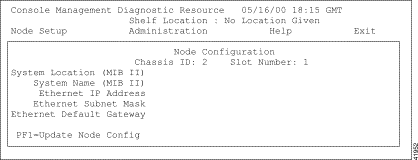
Step 9 You will see a screen prompting you to update the parameters. Use the arrow key to highlight Yes. Press <F1>.

Step 10 You will see a screen prompting you to reboot now. Highlight Yes and press <F1> if you can reboot safely, or No to reboot later.
Step 11 If you choose No and do not reboot, you will see the Node Setup screen, Figure 3-7 , again. Node Config will be highlighted. Press <Esc> to return to the main menu screenFigure 3-6.
Step 12 With the arrow key, highlight Administration and press <F1>. You will see a screen with two options: Set System Time and Operator Access.

Step 13 Set System Time will be highlighted. Press <F1>.
Step 14 You will see a Set System Time screen, Figure 3-19, prompting you for information on the system date, time, and time zone.

Enter the required information. Press <F1>.
Step 15 You will return to the Administration screen, Figure 3-10. If you have finished making changes and do not want to add a new user, then reboot.
Step 16 If you want to add a user, use the arrow key to highlight Operator Access. Press <F1>.
Step 17 You will see an Operator Access screen, Figure 3-20.

Step 18 New will be highlighted. Press <F1>.
Step 19 You will see the Add New Operator screen, Figure 3-13, prompting you to enter the new user's Login ID, Password, and Security level. Enter required information.

Step 20 To see the menu of possible security levels, highlight the Display Only Access and press <F1>.
Step 21 You will see the Display Access Screen, Figure 3-14. Use arrow key to select security level. Press <F1>.

Step 22 To reboot, use <Esc> to return to the Main Menu Screen, Figure 3-6. Use the arrow key to highlight the Exit option, and press <F1>.
After FDOS, the IMC's Ready LED will turn green, signalling that Network Address Translation (NAT) is possible.
The secondary IMC automatically derives FDOS configuration from the primary. The user does not have to perform FDOS on the secondary card.
Perform First Day of Service (FDOS) on the MGX 8240 to verify that the switch is ready to be managed by the Network Management System.
Before starting FDOS, you need the following:
To make an Ethernet connection, follow the steps below.
Step 1 Connect one end of a standard 10BaseT, RJ45 connector cable to your Ethernet hub. (See pinouts in the table below.)
| Pin No. | Signal |
|---|---|
1 | TDP |
2 | TDN (Transmit Data Positive) |
3 | RDP (Receive Data Positive) |
4 | No Connect |
5 | No Connect |
6 | RDN (Receive Data Negative) |
7 | No Connect |
8 | No Connect |
Step 2 Connect the other end of the cable to the Ethernet port at the top of the IMC I/O card.
 |
Note Before beginning FDOS on any PSM card, you must have done FDOS on the IMC card. |
All cards in the MGX 8240 chassis can have FDOS provisioning done through the primary IMC. Users open a CMDR session for each PSM to allow FDOS provisioning.
As each card is installed, you need to set the following values:
Step 1 In a terminal window, at the login prompt, enter the command sysadmin.
Step 2 At the password prompt, enter the password sysadmin.
Step 3 At the IMCCMDR> prompt, enter connect -slot <slot number of PSM card you wish to do FDOS on>
Step 4 At the CMDR> prompt, enter menus.
 |
Note In CMDR it is not necessary to type the whole command, but only the first letter(s) unique to the commands. For menu you could enter m. |
Step 5 You will see a screen with five options (Node Setup, Administration, Statistics, Help, Exit). Node Setup will be highlighted. Press <F1>.

Step 6 You will see the Node Setup screen, with two options: 1. Node Config and 2. SNMP Configuration. Node Configuration will be highlighted.Press <F1>.

You will see a Node Configuration screen (Figure 3-17). Enter information in the first two fields, System location and System name.
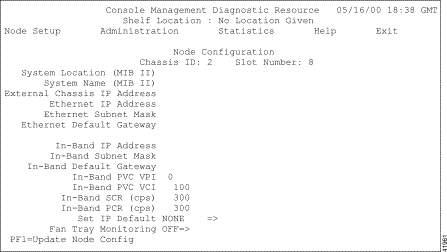
 |
Note Most of the fields on this screen pertain to in-band management, which is not supported by Release 3.0. You will leave most of the fields blank. Do not fill in any information other than system location, system name, and fan tray monitoring. |
Step 7 Enter information in the last field, Fan Tray Monitoring
Step 8 Press <F1>.
Step 9 You will see an Update Parameters screen. Use the arrow key to highlight Yes. Press <F1>.
Step 10 You will see a screen that prompting you to reboot. Highlight Yes and press <F1> if you can reboot safely and want to do so, or No to reboot later.
 |
Note If you reboot now, you will have to press <Control>+ T to return to the IMC CMDR. |
Step 11 If you choose No and do not reboot, you will see the Node Setup window Figure 3-16 again. Node Config will be highlighted. Press <Esc> to return to the main menu window Figure 3-15.
Step 12 With the arrow keys, highlight Administration. Press <F1>. You will see a screen with two options: 1. Set System Time and 2. Operator Access.

Step 13 Set System Time will be highlighted. Press <F1>.
Step 14 You will see a screen prompting you for information on the system date, time, and time zone. Enter the information.

Step 15 Press <F1>.
Step 16 You will return to the Administration screen Figure 3-18. If you have finished making changes and do not want to add a new user, then reboot.
Step 17 If you want to add a user, use the arrow key to highlight Operator Access. Press <F1>.
Step 18 You will see a new screen, on which New will be highlighted. Press <F1>.

Step 19 You will see the Add New Operator screen, Figure 3-21, prompting you to enter the new user's login ID, password, and security level. Enter ID and password information.

Step 20 To see the menu of possible security levels, highlight Display Only Access and press <F1>. You will see the Access screen, Figure 3-22. Highlight the desired security level. Press <F1>.
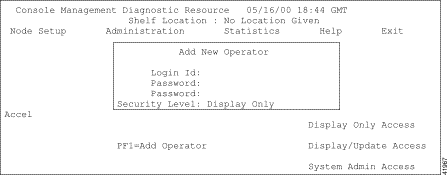
Step 21 To reboot, press <Esc> to return to the main menu. Use the arrow key to highlight the Exit option, and press <F1>.
Repeat the steps above for all other PSM cards in the chassis.
![]()
![]()
![]()
![]()
![]()
![]()
![]()
![]()
Posted: Sun Sep 29 05:21:42 PDT 2002
All contents are Copyright © 1992--2002 Cisco Systems, Inc. All rights reserved.
Important Notices and Privacy Statement.